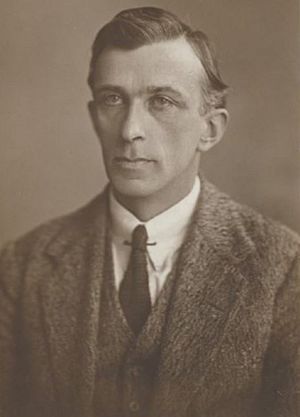Rory O'Connor (Irish republican) facts for kids
Quick facts for kids
Rory O'Connor
|
|
|---|---|

Portrait of O'Connor, early 1920s
|
|
| Born | 28 November 1883 Dublin, Ireland |
| Died | 8 December 1922 (aged 39) Mountjoy Gaol, Dublin, Ireland |
| Allegiance | Irish Republican Army (IRA) Irish Republican Brotherhood (IRB) Irish Volunteers |
| Service/ |
Anti-Treaty IRA |
| Rank | Commandant-general |
| Battles/wars | Easter Rising Irish War of Independence Irish Civil War |
Rory O'Connor (born November 28, 1883 – died December 8, 1922) was an important Irish revolutionary. He was a key leader in the IRA during the Irish War of Independence. He was in charge of engineering for the army.
Rory O'Connor did not agree with the Anglo-Irish Treaty of 1921. This treaty created the Irish Free State. He became a main spokesperson for the group that opposed the treaty. This group later became known as the Anti-Treaty IRA. In June 1922, the Irish Civil War began. O'Connor was captured by Free State soldiers during a battle at the Four Courts building in Dublin. On December 8, 1922, he was executed along with three other senior IRA members.
Contents
Early Life and Education
Rory O'Connor was born in Dublin, Ireland, on November 28, 1883. He went to school at St Mary's College, Dublin, and then to Clongowes Wood College. This was a boarding school in County Kildare. Interestingly, Kevin O'Higgins, who later signed O'Connor's execution order, also went to this school and was a close friend.
O'Connor studied science and engineering at University College Dublin. He earned a Bachelor of Arts degree in 1906 and an engineering degree in 1911. He was also active in student groups.
Engineering Career and Early Patriotism
After college, O'Connor became a railway engineer. He moved to Canada and worked for large railway companies. He helped build many miles of railroad tracks there.
In 1915, O'Connor returned to Ireland. He worked for Dublin Corporation as a civil engineer. He joined the Ancient Order of Hibernians, a group that supported Irish independence. In 1916, he took part in the Easter Rising. This was an important rebellion against British rule. O'Connor served as an intelligence officer in the General Post Office (GPO) during the Rising. He was injured by a sniper during this time.
Role in the War of Independence
From 1919 to 1921, Ireland fought for its independence from Britain. This was called the Irish War of Independence. During this time, Rory O'Connor was the Director of Engineering for the Irish Republican Army (IRA). The IRA was formed from the Irish Volunteers. His engineering and signaling skills were very important to the army.
O'Connor also helped with a famous escape from Strangeways Prison in Manchester, England, in October 1919. Six prisoners escaped, including Piaras Beaslaí. Michael Collins, another key Irish leader, was very interested in this escape and even visited the prison to help plan it.
The Anglo-Irish Treaty and Civil War
In 1921, the Anglo-Irish Treaty was signed. This treaty created the Irish Free State. However, it also meant that six counties in Northern Ireland would remain part of the United Kingdom. Rory O'Connor and many others in the IRA strongly opposed this treaty. They felt it did not give Ireland full independence and divided the country.
In early 1922, O'Connor became the chairman of a group called the Republican Military Council. This group was made up of senior IRA officers who rejected the Treaty. They wanted to keep fighting for a fully independent Irish Republic.
On March 26, 1922, anti-Treaty IRA officers held a meeting in Dublin. They voted to reject the Treaty and said they would not follow the Irish parliament (Dáil Éireann). When a journalist asked O'Connor if this meant they wanted a "military dictatorship," he replied, "You can take it that way if you want."
On April 14, 1922, O'Connor and about 200 other IRA members took over the Four Courts building in Dublin. This was a major government building. They hoped that taking over the building would make the British troops, who were still in Ireland, attack them. They believed this would restart the war with Britain and unite the IRA again against a common enemy.
Michael Collins tried to convince the IRA men to leave the Four Courts. However, the IRA was now split into two groups: those who supported the Treaty and those who opposed it.
On June 28, 1922, fighting broke out. After the Four Courts group kidnapped a general from the new Irish National Army, Collins ordered the shelling of the Four Courts building. This attack marked the official start of the Irish Civil War. The shelling caused a fire and damaged parts of the building. On June 30, O'Connor was one of 130 men who surrendered and were sent to Mountjoy Prison.
Execution
On December 8, 1922, Rory O'Connor was executed by firing squad. Three other republican leaders, Liam Mellows, Richard Barrett, and Joe McKelvey, were also executed with him. This happened in response to the anti-Treaty IRA killing a Free State politician named Sean Hales.
The order for O'Connor's execution was signed by Kevin O'Higgins. This was especially tragic because O'Connor had been the best man at O'Higgins' wedding just over a year earlier. Their deaths show how bitter and divided Ireland became during the Civil War. Rory O'Connor is seen as a hero by many in the Republican movement in Ireland. He was one of 77 republicans executed by the new Irish government.
Remembering Rory O'Connor
Rory O'Connor is remembered in several places in Ireland. There is a place called "Rory O'Connor Place" in Arklow. A pub in Crumlin, Dublin is named after him, and there is a housing estate called "Rory O'Connor Park" near Dún Laoghaire.
A student group at UCD is also named after him.
Images for kids




